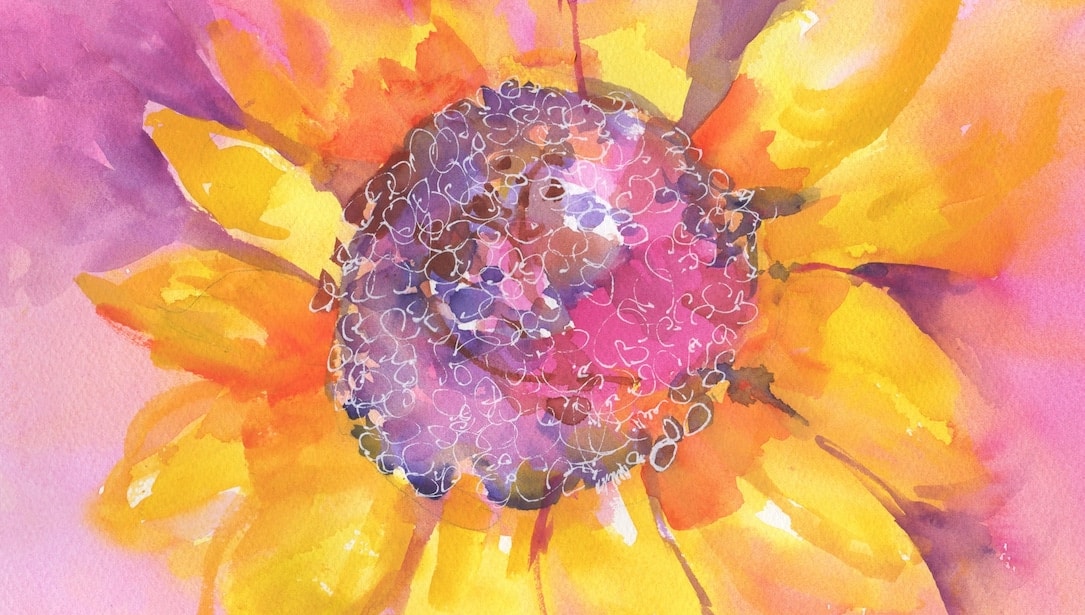Kathleen McElwaine came to us LIVE from the USA on Friday, July 29th to share her watercolor techniques and favorite color palette.
Here’s a quick Q&A with Kathleen:
Why do you make art?
Painting is my foundation and social center for how I relate to others. I use painting to express everything from my faith to my relationships with my family and friends.
How long have you been painting?
Since I was a child.
Did you have formal art training?
When I was 12 years old, I began studying art with Jay O’Meilia – I had 8 years of private instruction. He taught me the fundamentals, eye/hand control and how to discipline myself to draw every day. I sketched a lot with a light blue watercolor. Jay taught me the most important things, which I still use in my art career every day – patience, self discipline, humility, finding a way to serve my community, and always remember how hard I have practiced for what I have accomplished.
Are you a working artist or a hobbyist?
I am a working artist, yay! I worked hard to get here.
Who inspires you?
My dad.
What do you listen to while painting?
No music, but I like to listen for the birds outside my window.
Have you had a mentor?
Yes – Virginia Jarboe Rodecker from Tulsa, Oklahoma
Do you paint every day?
Yes – painting is like eating. I’m always planning classes and ways to paint. Teaching is a constant inspiration in my day to day painting.
Do you paint one piece at a time or work on several at the same time?
I usually have several paintings going at the same time. I stay inspired to paint. I can’t imagine living long enough to paint all the paintings in my head. And I want to teach others to paint them.
Do you create a concept piece first?
I create from my imagination, but I often use photos and plein air locations for reference. I was taught to plan a painting with a watercolor sketch. I sketch with a paint brush and then sometimes create something bigger from it, or sometimes it is just the sketch.
Do you prefer painting in studio or en plein air?
I was originally taught in studio, then Virgina showed me to plan my plein air paintings by painting a watercolor study on location and then paint an oil painting in my studio. Today I paint every place I go. Restaurants, coffee shops, in the car when I’m a passenger, even on trains, planes and buses when I travel.
How many core colors do you use?
On the right side of my palette, I have ten DANIEL SMITH colors consisting of primaries and secondaries, plus Quinacridone Burnt Orange and Indigo. I want my students to know how to use and recognize the paint colors. For instance, a color like Phthalo Blue Red Shade will scare you, it is so strong and hard to create a wash, yet it is one of the most usable colors on the palette, especially to create beautiful grays and dark black. Some of the PrimaTek colors like Serpentine Genuine are hard to wake up, but I want them to know how to use it and appreciate its qualities. I teach students about the pigments’ characteristics and why it’s important, like what you need to know about staining in order to lift color. The science of color is there to prevent us from having to guess or go through a lot of trial and error.
Tubes, pans or sticks?
I like any form of DANIEL SMITH paints. I enjoy the sticks immensely because the color seems to be so rich, so fast. I love new colors. And I am very proud of my dot card.
When do you know that your piece is finished?
It depends on the painting, could take 30 minutes to 2 hours. You know it is done when you don’t know what else to do.
••••••••••
Join us online each week for an Up Close and Personal Conversation with Daniel Smith CEO and Owner, John Cogley and guest artists from around the world. On Thursdays (2:00pm Pacific), John highlights various features of our products and answers your questions. On Fridays (10:30am Pacific), a guest artist follows up to share how they incorporate those features into their art. Click here for the upcoming week’s Zoom links.
Check our Facebook page for news about upcoming guest artists or to watch past replays. Each Zoom meeting is also recorded and shared on our YouTube channel. La traducción al español está disponible – selecciona el canal en español en Zoom.







